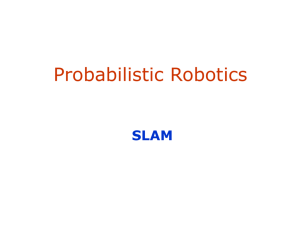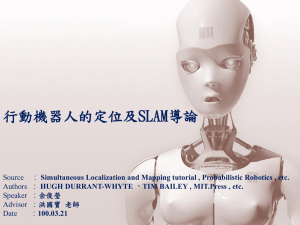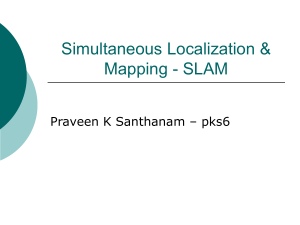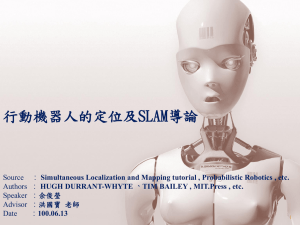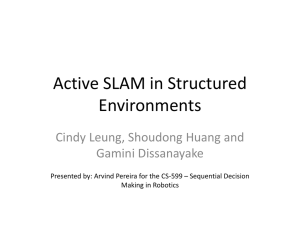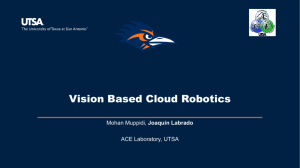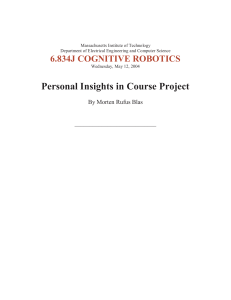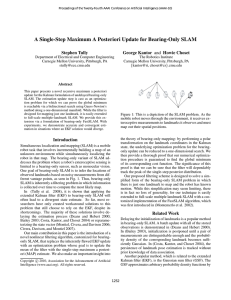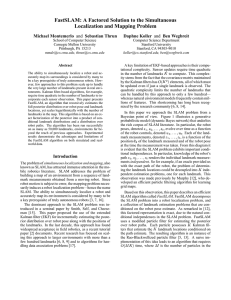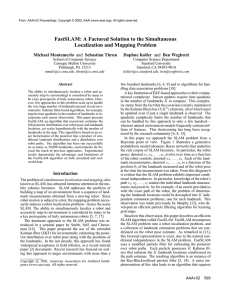SLAM - CUNY.edu
advertisement
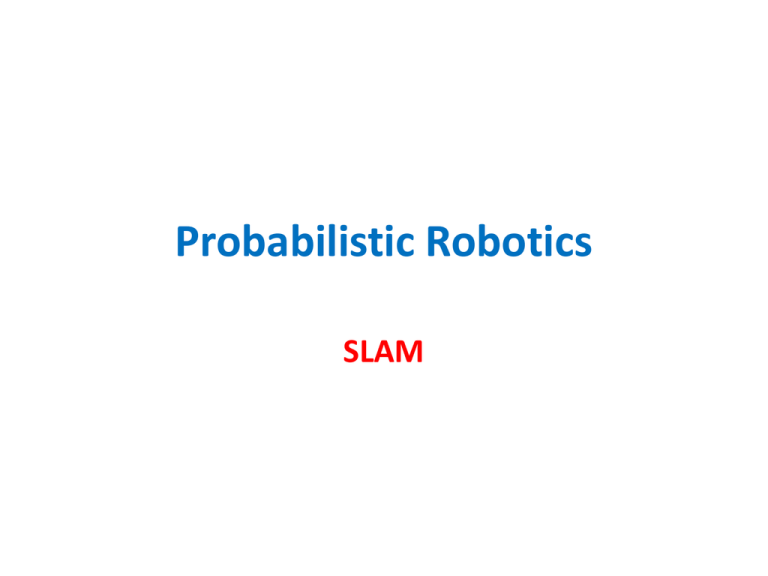
Probabilistic Robotics SLAM The SLAM Problem A robot is exploring an unknown, static environment. Given: • The robot’s controls (U1:t) • Observations of nearby features (Z1:t) Estimate: • Map of features (m) • Pose / Path of the robot (xt) 2 Why is SLAM a hard problem? Robot pose uncertainty • In the real world, the mapping between • observations and landmarks is unknown Picking wrong data associations can have catastrophic consequences 3 Nature of the SLAM Problem Continuous component Location of objects in the map Robot’s own pose Discrete component Correspondence Object is the same or not 4 SLAM: Simultaneous Localization and Mapping • Full SLAM: Estimates entire path and map! p( x1:t , m | z1:t , u1:t ) Estimates Given Entire pose (x1:t) and map (m) Previous knowledge (Z1:t-1, U1:t-1) Current measurement (Zt, Ut) 5 Graphical Model of Full SLAM: p( x1:t , m | z1:t , u1:t ) 6 SLAM: Simultaneous Localization and Mapping • Online SLAM: p( xt , m | z1:t , u1:t ) Estimates Given Most recent pose (xt) and map (m) Previous knowledge (Z1:t-1, U1:t-1) Current measurement (Zt, Ut) Estimates most recent pose and map! 7 Graphical Model of Online SLAM: p( xt , m | z1:t , u1:t ) p( x1:t , m | z1:t , u1:t ) dx1 dx2 ...dxt 1 Integrations typically done one at a time 8 SLAM with Extended Kalman Filter • Pre-requisites • Maps are feature-based (landmarks) small number (< 1000) • Assumption - Gaussian Noise • Process only positive sightings No landmark = negative Landmark = positive 9 EKF-SLAM with known correspondences Correspondence Data association problem Landmarks can’t be uniquely identified Correspondence variable (Cit) True identity of observed feature between feature (fit) and real landmark f t rt i i i t S i T t 10 EKF-SLAM with known correspondences Signature Numerical value (average color) Characterize type of landmark (integer) Multidimensional vector (height and color) 11 EKF-SLAM with known correspondences Similar development to EKF localization Diff robot pose + coordinates of all landmarks Combined state vector xt yt x m y m1, x p( yt | z1:t , u1:t ) m1, y S1 ... mN , x (3N + 3) mN , y SN T Online posterior 12 Mean Motion update Covariance Test for new landmarks Initialization of elements Expected measurement Iteration through measurements Filter is updated 13 EKF-SLAM with known correspondences Observing a landmark improves robot pose estimate eliminates some uncertainty of other landmarks Improves position estimates of the landmark + other landmarks We don’t need to model past poses explicitly 14 EKF-SLAM with known correspondences Example: 15 EKF-SLAM with known correspondences Example: • Uncertainty of landmarks are mainly due to robot’s pose uncertainty (persist over time) Estimated location of landmarks are correlated 16 EKF-SLAM with unknown correspondences • No correspondences for landmarks • Uses an incremental maximum likelihood (ML) estimator Determines most likely value of the correspondence variable Takes this value for granted later on 17 EKF-SLAM with unknown correspondences Mean Motion update Covariance Hypotheses of new landmark 18 19 General Problem Gaussian noise assumption Unrealistic Spurious measurements Fake landmarks Outliers Affect robot’s localization 20 Solutions to General Problem Provisional landmark list New landmarks do not augment the map Not considered to adjust robot’s pose Consistent observation regular map 21 Solutions to General Problem Landmark Existence Probability Landmark is observed Observable variable (o) increased by fixed value Landmark is NOT observed when it should Observable variable decreased Removed from map when (o) drops below threshold 22 Problem with Maximum Likelihood (ML) Once ML estimator determines likelihood of correspondence, it takes value for granted always correct Makes EKF susceptible to landmark confusion Wrong results 23 Solutions to ML Problem Spatial arrangement Greater distance between landmarks Less likely confusion will exist Trade off: few landmarks harder to localize Little is known about optimal density of landmarks Signatures Give landmarks a very perceptual distinctiveness (e,g, color, shape, …) 24 EKF-SLAM Limitations • Selection of appropriate landmarks • Reduces sensor reading utilization to presence or absence of those landmarks Lots of sensor data is discarded • Quadratic update time Limits algorithm to scarce maps (< 1000 features) • Low dimensionality of maps harder data association problem 25 EKF-SLAM Limitations • Fundamental Dilemma of EKF-SLAM It might work well with dense maps (millions of features) It is brittle with scarce maps BUT It needs scarce maps because of complexity of the algorithm (update process) 26 SLAM Techniques • EKF SLAM (chapter 10) • Graph-SLAM (chapter 11) • SEIF (chapter 12) • Fast-SLAM (chapter 13) 27 Graph-SLAM • Solves full SLAM problem • Represents info as a graph of soft constraints • Accumulates information into its graph without resolving it (lazy SLAM) • Computationally cheap • At the other end of EKF-SLAM Process information right away (proactive SLAM) Computationally expensive 28 Graph-SLAM • Calculates posteriors over robot path (not incremental) • Has access to the full data • Uses inference to create map using stored data Offline algorithm 29 Sparse Extended Information Filter (SEIF) • Implements a solution to online SLAM problem • Calculates current pose and map (as EKF) • Stores information representation of all knowledge (as Graph-SLAM) Runs Online and is computationally efficient • Applicable to multi-robot SLAM problem 30 FastSLAM Algorithm • • • • Particle filter approach to the SLAM problem Maintain a set of particles Particles contain a sampled robot path and a map The features of the map are represented by own local Gaussian • Map is created as a set of separate Gaussians Map features are conditionally independent given the path Factoring out the path (1 per particle) Map feature become independent Eliminates the need to maintain correlation among them 31 FastSLAM Algorithm • Updating in FastSLAM Sample new pose update the observed features • Update can be performed online • Solves both online and offline SLAM problem • Instances Feature-based maps Grid-based algorithm 32 Approximations for SLAM Problem • Local submaps [Leonard et al.99, Bosse et al. 02, Newman et al. 03] • Sparse links (correlations) [Lu & Milios 97, Guivant & Nebot 01] • Sparse extended information filters [Frese et al. 01, Thrun et al. 02] • Thin junction tree filters [Paskin 03] • Rao-Blackwellisation (FastSLAM) [Murphy 99, Montemerlo et al. 02, Eliazar et al. 03, Haehnel et al. 03] 33 Thanks !! 34

